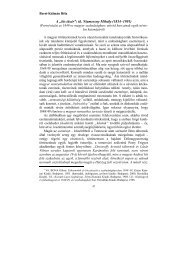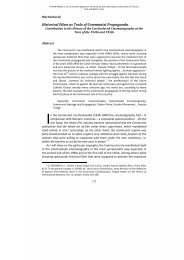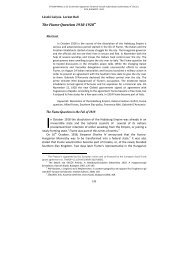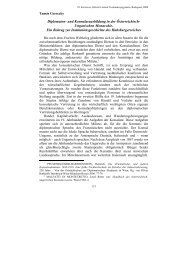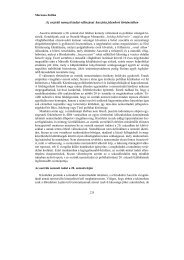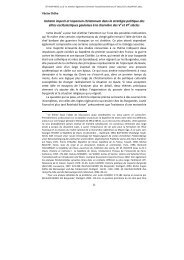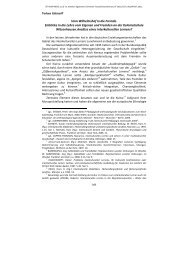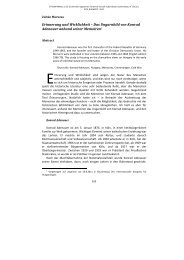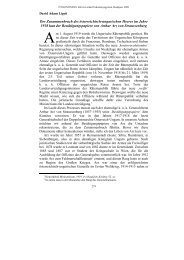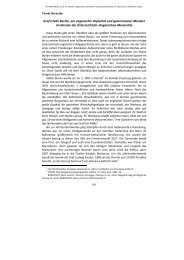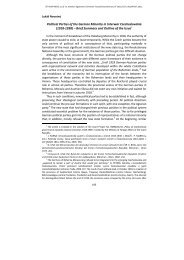The Molotov-Ribbentrop Pact - ELTE BTK Történelem Szakos Portál
The Molotov-Ribbentrop Pact - ELTE BTK Történelem Szakos Portál
The Molotov-Ribbentrop Pact - ELTE BTK Történelem Szakos Portál
You also want an ePaper? Increase the reach of your titles
YUMPU automatically turns print PDFs into web optimized ePapers that Google loves.
<strong>The</strong> goal of my work in this international framework will be to further<br />
deconstruct the outmoded Austrian „Opferthese” 7 and to show, that many<br />
Austrians were not only working wheels in the NS-Apparatus, but often also, as<br />
in the case of Eichmann will be significantly, used their granted freedom and<br />
set accents out of their own initiatives, leading to a „cumulative<br />
radicalization” 8 of the Nazi power apparatus and consequently to a further<br />
deterioration of the living condition of Jews and other minorities like the Roma<br />
and Sinti, homosexuals, the so-called anti-socials and others.<br />
<strong>The</strong> functioning of this power structure and its simultaneous continued<br />
radicalization that took place with the participation also of many Austrians,<br />
some in high places, as can be seen at the position of Eichmann, was finally<br />
culminating in a state terror that killed millions of people.<br />
However, for all these considerations of a unfortunately, all too well<br />
functioning „machinery of death” 9 , as it is defined in the investigations of Raul<br />
Hilberg, it must not be overlooked on the fact, that the apparatus is composed<br />
of individual persons, and therefore of individual offenders. One of those<br />
7 Under the term „Opferthese” („victim theory”) is meant a long time course of argument in<br />
Austria. It says that Austria was the first victim of Nazi aggression policy. As a result, an<br />
Austrian complicity was denied in the collective memory of whole generations. For this reason it<br />
is also commonly called the „Life lie” („Lebenslüge”) of Republic II. <strong>The</strong> consequences of the<br />
„Opferthese” was in addition to an inadequately implemented denazification in post war years,<br />
also a long time insufficient „compensation policy” from the Republic towards the victims of the<br />
National Socialism. Accordingly, it lacked until late in the 1990s to a reappraisal of the Austrian<br />
past in the era of National Socialism. It was not until the year 1986 during the Waldheim affair<br />
and also in the commemorative year 1988, that a sophisticated discussion of the Nazi past of<br />
Austria set in. In 1991 Chancellor Franz Vranitzky was the first official representative of the<br />
Republic, who admitted the crimes, that where committed by Austrians, and also asked for<br />
excuse. Also the reactions of the Republic to the sanctions of the formerly 14 other states of the<br />
EU after the ÖVP-FPÖ Coalition formation, is regarded as a late symptom of the „Opferthese”,<br />
because also in that case the Republic see itself as an innocent victim.<br />
8 <strong>The</strong> term comes from the discourse of the various and contradictory interpretations of the<br />
development of Nazi genocide policies.<br />
9 This Term, in the original „Vernichtungsmaschinerie” came from Raul HILBERG’s<br />
standard work „Die Vernichtung der Europäischen Juden”. With this term he refers to the<br />
Nazi Apparatus, which carried out the genocides and he made clear, that this Apparatus was<br />
composed out of four hierarchic groups: <strong>The</strong> officials brought in their incorruptible planning<br />
and managerial thoroughness. From the Wehrmacht the machinery of destruction got military<br />
discipline, precision and endurance. <strong>The</strong> influence of the industry got visible both in the<br />
emphatically driven accounting, thrift and recycling as well as in a factory environment<br />
efficiency of the extermination camps. <strong>The</strong> party finally supplied the machine with „idealism”,<br />
the „sense of mission” and the sense of „making history” […]. In the original: „Die<br />
Beamtenschaft brachte ihre unbestechliche planerische und verwalterische Gründlichkeit ein.<br />
Von der Wehrmacht erhielt die Vernichtungsmaschinerie militärische Disziplin, Präzision und<br />
Ausdauer. Der Einfluß der Industrie wurde sowohl in der mit großem Nachdruck betriebenen<br />
Buchführung, Sparsamkeit und Wiederverwertung als auch in der fabrikmäßigen Effizienz der<br />
Vernichtungszentren sichtbar. Die Partei schließlich versah den Apparat mit „Idealismus”,<br />
„Sendungsbewusstsein” und dem Gefühl, „Geschichte zu machen”. […]” HILBERG, Raul:<br />
<strong>The</strong> destruction of the European Jews. Chicago, 1961. 39.<br />
76



